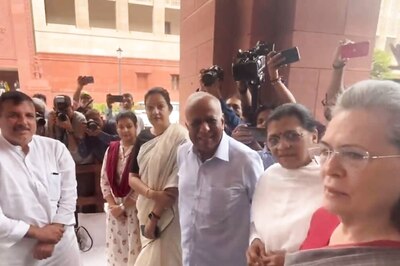
views
Recruitment to the Indian Armed Forces under the newly launched Tour of Duty or Agnipath scheme is likely to progressively increase over the next four years to nearly 59,000 soldiers, airmen, and sailors—from about 46,000 in the first year—senior government officials told News18.
The scheme, which will replace the existing processes for recruitment into the Army, Navy, and the Indian Air Force (IAF) was unveiled on Tuesday by defence minister Rajnath Singh and was hailed as “transformational”. Recruitment rallies to the services are set to begin within 90 days.
Gradual growth
Under the scheme, the Army is set to induct around 40,000 soldiers, the Navy 3,000 sailors, and the IAF 3,000 airmen in the first year.
An official told News18 that as per current plans, in the second year, the total intake would likely go up to about 46,500, of which the Army’s and the Navy’s numbers would remain the same at nearly 40,000 and 3,000, but the IAF’s figure would go up to about 3,500.
In the third year, there are plans to recruit close to 52,400 youth, of which, the Army’s intake would be approximately 45,000, the Navy’s 3,000, and the IAF’s 4,400.
The Armed Forces plan to induct around 58,800 youth in the fourth year, of which the Army’s intake is likely to be about 50,000, the Navy’s 3,500, and the IAF’s 5,300.
The increased intake will significantly take care of the shortfall of Armed Forces personnel created in the last two years when recruitments remained stalled.
Skill development ministry to issue elaborate certificates
Sources told News18 that a centralised digital database will be created by the three services on the Agniveers or the soldiers who join the scheme to track and keep a record of the skills they imbibe during their four-year tenure.
“Additionally, the services would also be drafting a robust assessment system for the Agniveers, which will help keep track of their performance,” a source said.
Sources indicated that when the Agniveers are released after four years, the ministry of skill development and entrepreneurship is likely to be roped in for issuing an elaborate skill-set certificate highlighting their competency.
Defence minister Rajnath Singh said on Tuesday that various states and ministries in the central government are working towards ensuring that the Agniveers get preference in jobs after they complete their tenure, indicating a whole-of-government approach to the scheme. He had said the full picture will emerge in a few days.
Following this, home minister Amit Shah said on Wednesday that the Agniveers who complete their four years’ service will be given priority for jobs in paramilitary forces and Assam Rifles.
“Agnipath Yojana is a visionary and welcome decision of Prime Minister Narendra Modi for the bright future of the youth. In this context, today, the ministry of home affairs (MHA) has decided to give priority to Agniveers who complete 4 years under this scheme for recruitment in CAPFs (central armed police forces) and Assam Rifles,” he tweeted.
All sailors, airmen, and soldiers, except the technical cadre of the medical branch, will be recruited to the services under the scheme.
They will be provided a contributory financial package called Seva Nidhi when they are released. Additionally, they will be incentivised with higher educational credits, lateral absorption, and other bridging courses when they are released after four years, the government had said.
The youth between the ages of 17.5 and 21 years will be inducted into the Armed Forces under the scheme for four years. After exiting the services at the end of that period, up to 25% of them can apply voluntarily to join the services on a regular basis, depending on merit and organisational requirements.
It will be open to men and also to women progressively based on service-specific requirements. Their enrolment will be based on an ‘all-India, all-class’ basis. They will form a separate rank in the Armed Forces and carry a distinct insignia.
While the government has called the scheme transformational, it has evoked sharp responses from veterans. Several retired defence personnel have argued that it should have been first tested on a small scale before fully implementing it in one go. Others have pointed out that the scheme should have been employed for all ranks.
Read all the Latest News , Breaking News , watch Top Videos and Live TV here.



















Comments
0 comment